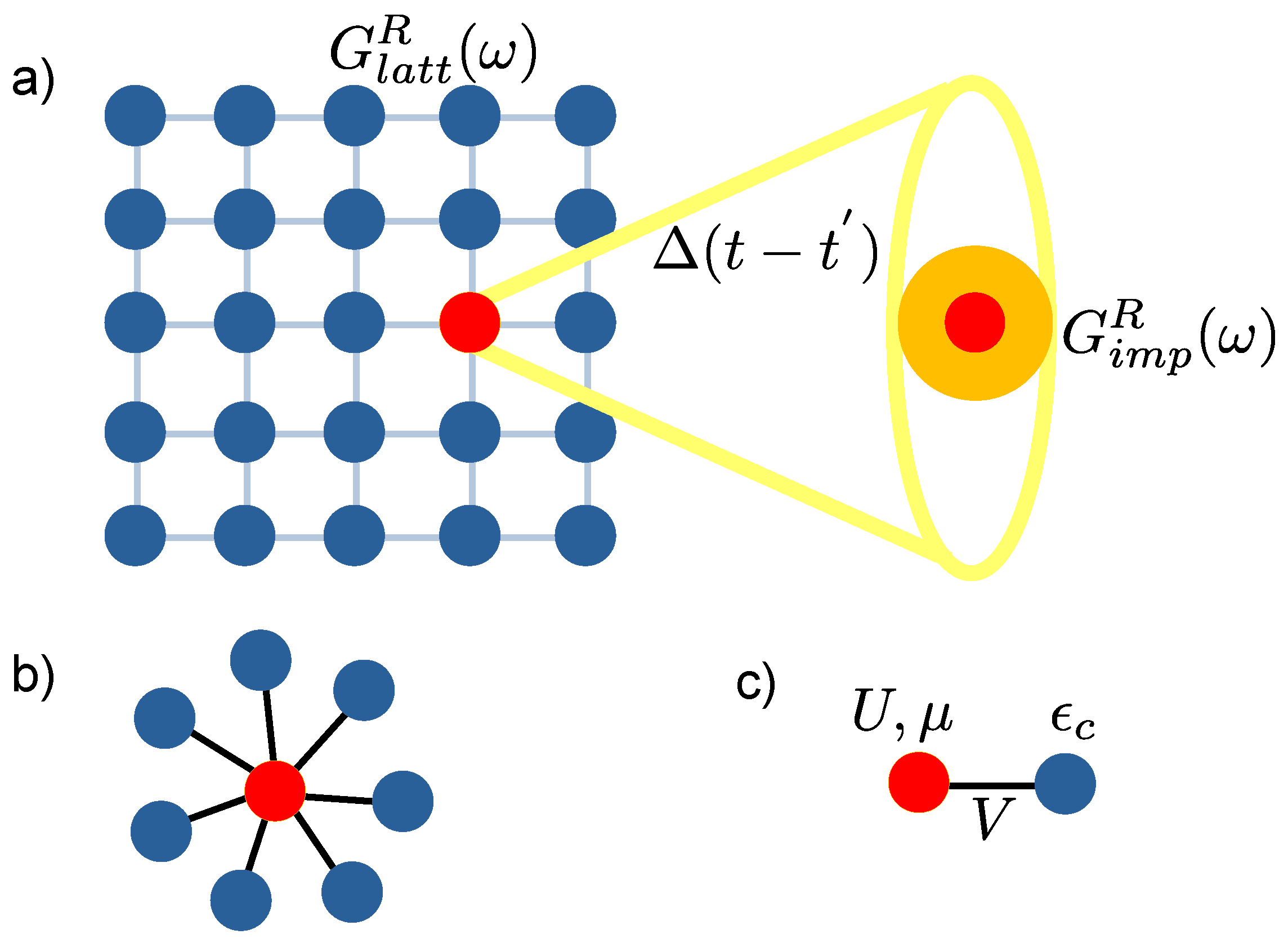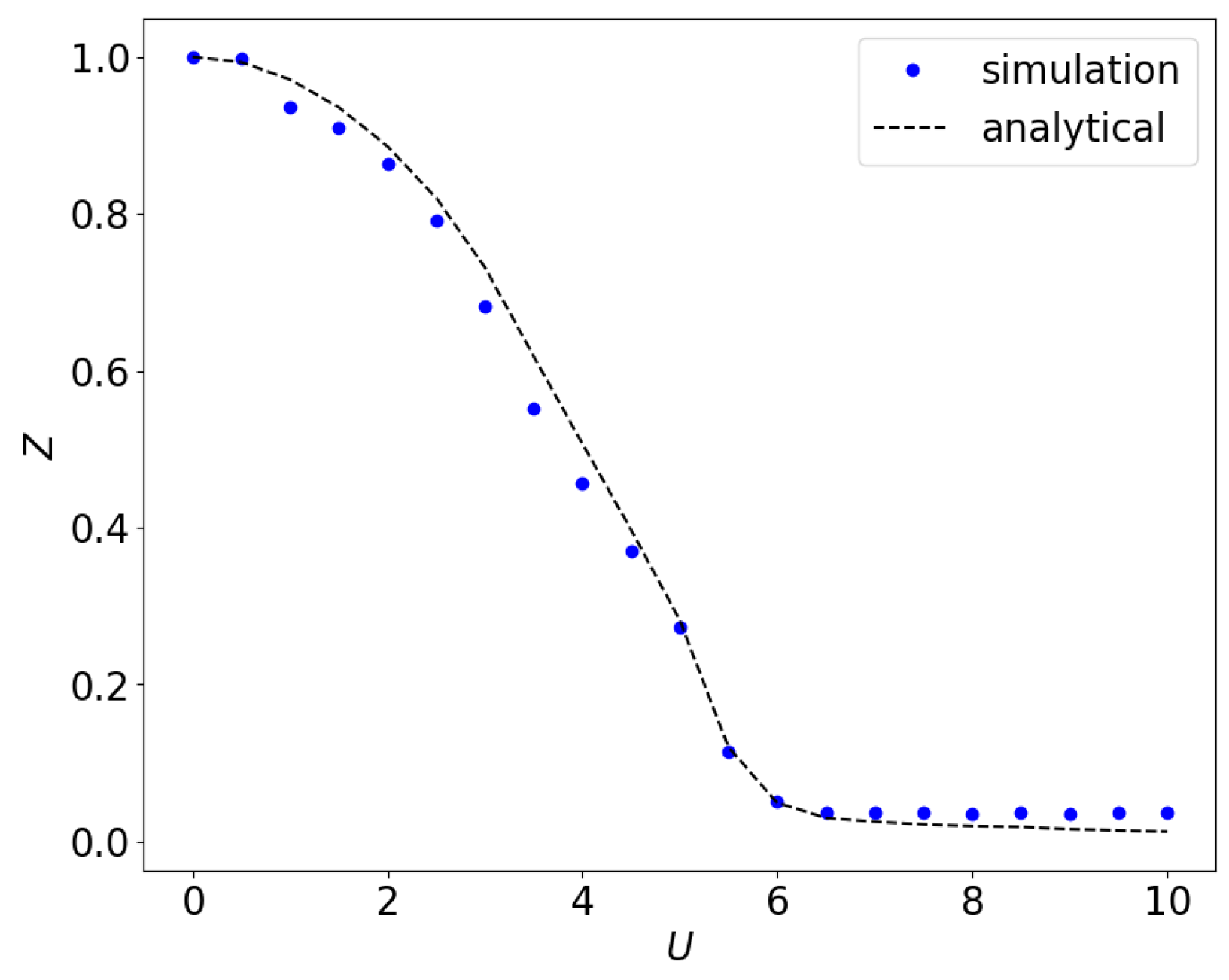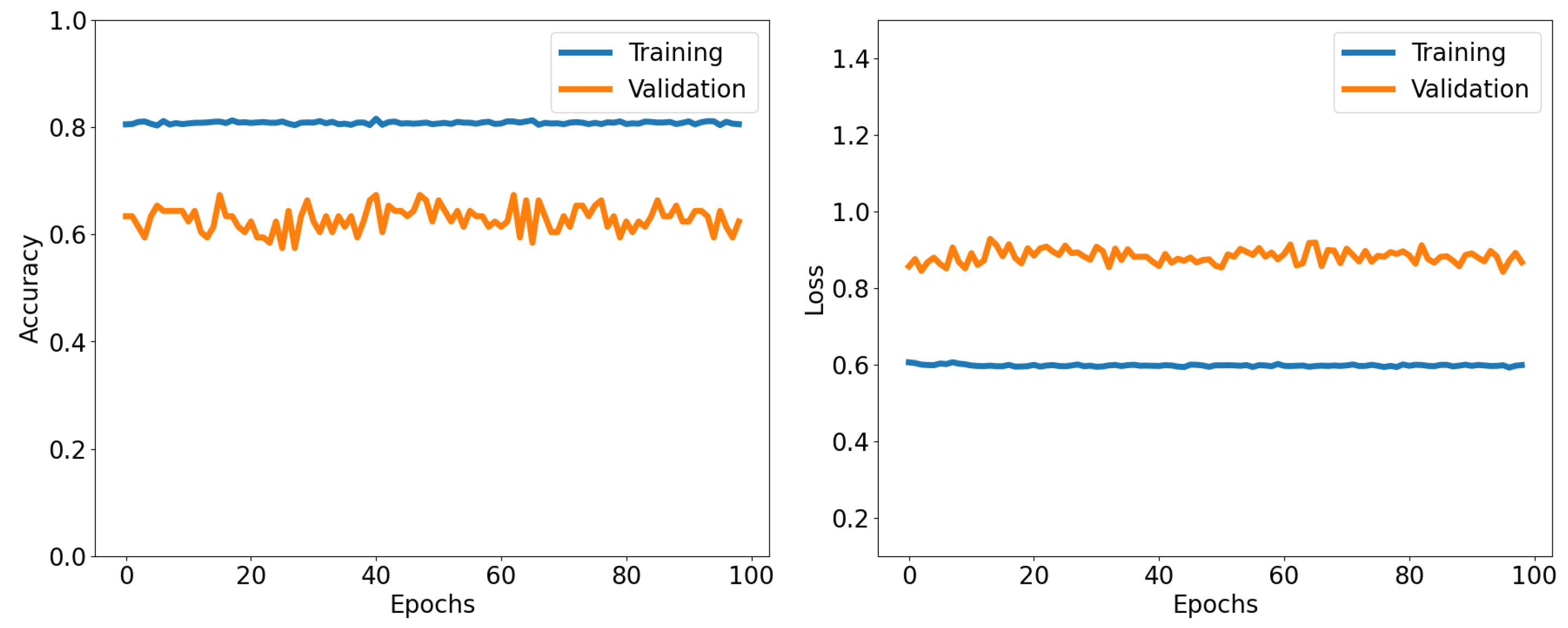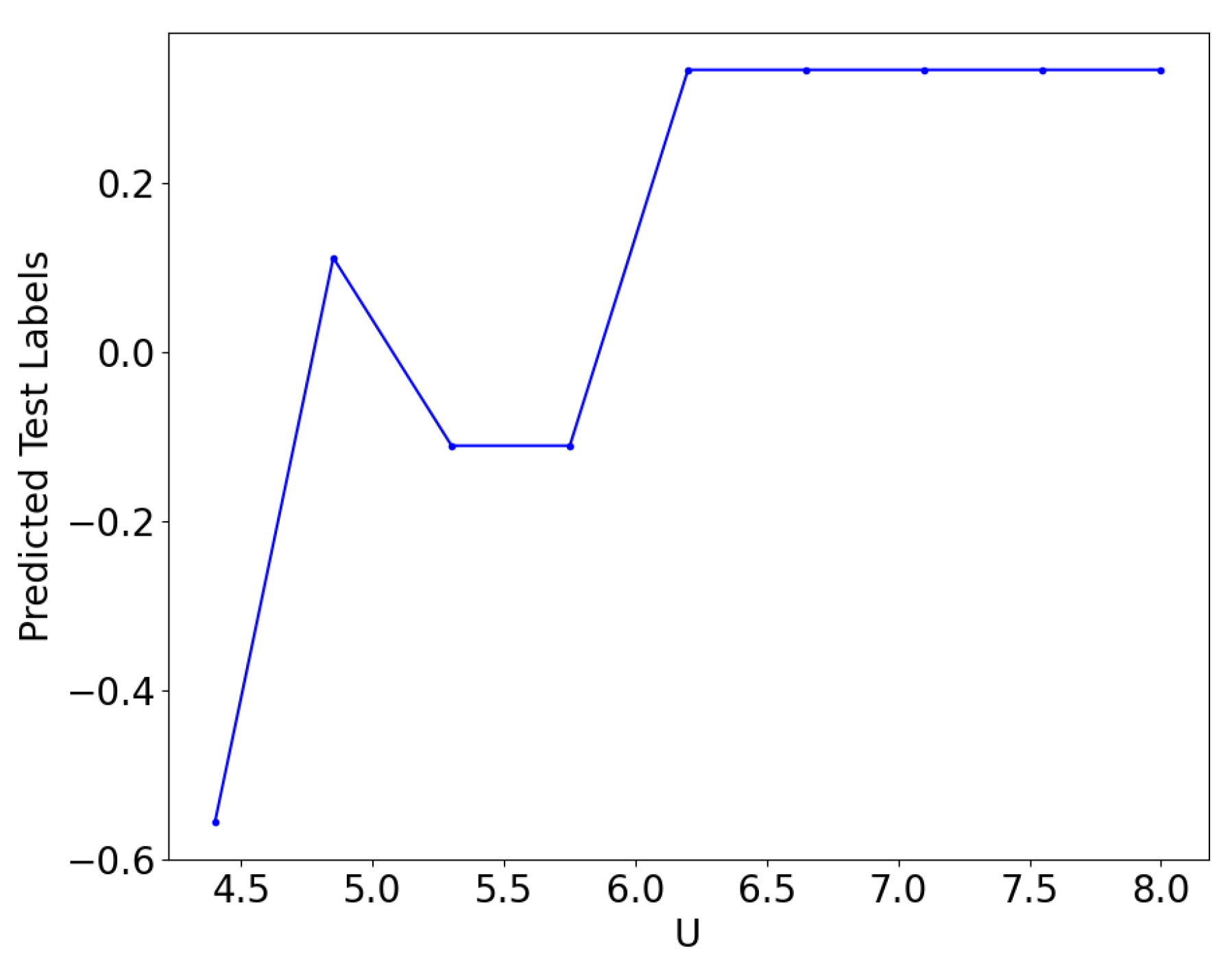Quantum Classical Algorithm for the Study of Phase Transitions in the Hubbard Model via Dynamical Mean-Field Theory
Abstract
1. Introduction
2. Dynamical Mean Field Theory (DMFT)
3. Methods and Procedure
3.1. Jordan–Wigner Transformation for Mapping the Fermions to Qubits
3.2. Self-Energy of the Two-Site Model
3.3. Flowchart of the Algorithm
- U and are fixed to the desired value in the SIAM, and we set the unknown parameters for half-filling, and V to an initial guess.
- Then, we measure the interacting Green’s function using the technique of single-qubit interferometry.
- We Fourier transform the impurity Green’s function by fitting it according to Equation (2).
- We calculate the coefficients for the self-energy by using the Dyson equation in the time domain.
- We measure the quasiparticle weight using the self-energy.
- We update the hopping parameter V.
- We repeat steps 2–6 until the self-energy is converged.
4. Implementation
4.1. Ground-State Ansatz
4.2. Retarded Impurity Green’s Function
5. Results
6. Classification Using Quantum Machine Learning(QML)
6.1. QML as a Classifier of Wavefunctions
6.2. Implementation of the Quantum Convolutional Neural Network (QCNN) to Classify the Wavefunctions from the DMFT
7. Classifier Results Using a QCNN
7.1. Training QCNN with Data for Randomly Picked Data for
7.2. Training QCNN with Data for and
8. Discussion
9. Conclusions
Author Contributions
Funding
Data Availability Statement
Conflicts of Interest
Appendix A
Appendix A.1. Dynamical Mean Field Theory (DMFT)
Appendix A.2. Two-Site DMFT
Appendix A.3. Jordan–Wigner Transformation for Mapping the Fermions to Qubits
Appendix A.4. Entanglement Entropy
References
- Varma, C.; Nussinov, Z.; van Saarloos, W. Singular or non-Fermi liquids. Phys. Rep. 2002, 361, 267. [Google Scholar] [CrossRef]
- Savary, L.; Balents, L. Quantum spin liquids: A review. Rep. Prog. Phys. 2016, 80, 016502. [Google Scholar] [CrossRef] [PubMed]
- Stewart, G.R. Heavy-fermion systems. Rev. Mod. Phys. 1984, 56, 755–787. [Google Scholar] [CrossRef]
- Proust, C.; Taillefer, L. The Remarkable Underlying Ground States of Cuprate Superconductors. Annu. Rev. Condens. Matter Phys. 2019, 10, 409–429. [Google Scholar] [CrossRef]
- Varma, C.M. Colloquium: Linear in temperature resistivity and associated mysteries including high temperature superconductivity. Rev. Mod. Phys. 2020, 92, 031001. [Google Scholar] [CrossRef]
- Kanamori, J. Electron correlation and ferromagnetism of transition metals. Prog. Theor. Exp. Phys 1963, 30, 275–289. [Google Scholar]
- Hubbard, J. Electron correlations in narrow energy bands. Proc. Math. Phys. Eng. Sci. 1963, 276, 238–257. [Google Scholar] [CrossRef]
- Georges, A.; Kotliar, G. Hubbard model in infinite dimensions. Phys. Rev. B 1992, 45, 6479. [Google Scholar] [CrossRef]
- Georges, A.; Kotliar, G.; Krauth, W.; Rozenberg, M.J. Dynamical mean-field theory of strongly correlated fermion systems and the limit of infinite dimensions. Rev. Mod. Phys. 1996, 68, 13–125. [Google Scholar] [CrossRef]
- Müller-Hartmann, E. The Hubbard model at high dimensions: Some exact results and weak coupling theory. Z. Phys. B 1989, 76, 211–217. [Google Scholar] [CrossRef]
- Müller-Hartmann, E. Correlated fermions on a lattice in high dimensions. Z. Phys. B 1989, 74, 507–512. [Google Scholar] [CrossRef]
- Metzner, W.; Vollhardt, D. Correlated Lattice Fermions in d=∞ Dimensions. Phys. Rev. Lett. 1989, 62, 324–327. [Google Scholar] [CrossRef]
- Jarrell, M. Hubbard model in infinite dimensions: A quantum Monte Carlo study. Phys. Rev. Lett. 1992, 69, 168–171. [Google Scholar] [CrossRef] [PubMed]
- Toschi, A.; Katanin, A.A.; Held, K. Dynamical vertex approximation: A step beyond dynamical mean-field theory. Phys. Rev. B 2007, 75, 045118. [Google Scholar] [CrossRef]
- Rubtsov, A.N.; Katsnelson, M.I.; Lichtenstein, A.I.; Georges, A. Dual fermion approach to the two-dimensional Hubbard model: Antiferromagnetic fluctuations and Fermi arcs. Phys. Rev. B 2009, 79, 045133. [Google Scholar] [CrossRef]
- Fotso, H.F.; Tam, K.M.; Moreno, J. Beyond quantum cluster theories: Multiscale approaches for strongly correlated systems. Quantum Sci. Technol. 2022, 7, 33001. [Google Scholar] [CrossRef]
- Slezak, C.; Jarrell, M.; Maier, T.; Deisz, J. Multi-scale extensions to quantum cluster methods for strongly correlated electron systems. J. Condens. Matter Phys. 2009, 21, 435604. [Google Scholar] [CrossRef]
- Hague, J.P.; Jarrell, M.; Schulthess, T.C. Fluctuation-exchange supplemented quantum Monte Carlo approach to the Hubbard model. Phys. Rev. B 2004, 69, 165113. [Google Scholar] [CrossRef]
- Rohringer, G.; Hafermann, H.; Toschi, A.; Katanin, A.A.; Antipov, A.E.; Katsnelson, M.I.; Lichtenstein, A.I.; Rubtsov, A.N.; Held, K. Diagrammatic routes to nonlocal correlations beyond dynamical mean field theory. Rev. Mod. Phys. 2018, 90, 025003. [Google Scholar] [CrossRef]
- Hettler, M.H.; Mukherjee, M.; Jarrell, M.; Krishnamurthy, H.R. Dynamical cluster approximation: Nonlocal dynamics of correlated electron systems. Phys. Rev. B 2000, 61, 12739–12756. [Google Scholar] [CrossRef]
- Fotso, H.; Yang, S.; Chen, K.; Pathak, S.; Moreno, J.; Jarrell, M.; Mikelsons, K.; Khatami, E.; Galanakis, D. Dynamical Cluster Approximation. In Strongly Correlated Systems: Theoretical Methods; Avella, A., Mancini, F., Eds.; Springer: Berlin/Heidelberg, Germany, 2012; pp. 271–302. [Google Scholar] [CrossRef]
- Biroli, G.; Kotliar, G. Cluster methods for strongly correlated electron systems. Phys. Rev. B 2002, 65, 155112. [Google Scholar] [CrossRef]
- Knizia, G.; Chan, G.K.L. Density Matrix Embedding: A Simple Alternative to Dynamical Mean-Field Theory. Phys. Rev. Lett. 2012, 109, 186404. [Google Scholar] [CrossRef] [PubMed]
- Arsenault, L.F.; Lopez-Bezanilla, A.; von Lilienfeld, O.A.; Millis, A.J. Machine learning for many-body physics: The case of the Anderson impurity model. Phys. Rev. B 2014, 90, 155136. [Google Scholar] [CrossRef]
- Rigo, J.B.; Mitchell, A.K. Machine learning effective models for quantum systems. Phys. Rev. B 2020, 101, 241105. [Google Scholar] [CrossRef]
- Sheridan, E.; Rhodes, C.; Jamet, F.; Rungger, I.; Weber, C. Data-driven dynamical mean-field theory: An error-correction approach to solve the quantum many-body problem using machine learning. Phys. Rev. B 2021, 104, 205120. [Google Scholar] [CrossRef]
- Walker, N.; Kellar, S.; Zhang, Y.; Tam, K.M.; Moreno, J. Neural Network Solver for Small Quantum Clusters. Crystals 2022, 12, 1269. [Google Scholar] [CrossRef]
- Sturm, E.J.; Carbone, M.R.; Lu, D.; Weichselbaum, A.; Konik, R.M. Predicting impurity spectral functions using machine learning. Phys. Rev. B 2021, 103, 245118. [Google Scholar] [CrossRef]
- Bauer, B.; Wecker, D.; Millis, A.J.; Hastings, M.B.; Troyer, M. Hybrid Quantum-Classical Approach to Correlated Materials. Phys. Rev. X 2016, 6, 031045. [Google Scholar] [CrossRef]
- Keen, T.; Maier, T.; Johnston, S.; Lougovski, P. Quantum-classical simulation of two-site dynamical mean-field theory on noisy quantum hardware. Quantum Sci. Technol. 2020, 5, 035001. [Google Scholar] [CrossRef]
- Kreula, J.M.; García-Álvarez, L.; Lamata, L.; Clark, S.R.; Solano, E.; Jaksch, D. Few-qubit quantum-classical simulation of strongly correlated lattice fermions. EPJ Quantum Technol. 2016, 3, 11. [Google Scholar] [CrossRef]
- Steckmann, T.; Keen, T.; Kökcü, E.; Kemper, A.F.; Dumitrescu, E.F.; Wang, Y. Mapping the metal-insulator phase diagram by algebraically fast-forwarding dynamics on a cloud quantum computer. Phys. Rev. Res. 2023, 5, 023198. [Google Scholar] [CrossRef]
- Jaderberg, B. Solving Optimisation Problems on Near-Term Quantum Computers. Ph.D. Thesis, University of Oxford, Oxford, UK, 2022. [Google Scholar]
- Rungger, I.; Fitzpatrick, N.; Chen, H.; Alderete, C.H.; Apel, H.; Cowtan, A.; Patterson, A.; Ramo, D.M.; Zhu, Y.; Nguyen, N.H.; et al. Dynamical Mean Field Theory Algorithm and Experiment on Quantum Computers. Quantum Sci. Technol. 2021, 6, 025004. [Google Scholar] [CrossRef]
- Jaderberg, B.; Agarwal, A.; Leonhardt, K.; Kiffner, M.; Jaksch, D. Minimum hardware requirements for hybrid quantum–classical DMFT. Quantum Sci. Technol. 2020, 5, 034015. [Google Scholar]
- Johnston, S.; Khatami, E.; Scalettar, R. A perspective on machine learning and data science for strongly correlated electron problems. Carbon Trends 2022, 9, 100231. [Google Scholar]
- Wang, L. Discovering phase transitions with unsupervised learning. Phys. Rev. B 2016, 94, 195105. [Google Scholar] [CrossRef]
- Wetzel, S.J. Unsupervised learning of phase transitions: From principal component analysis to variational autoencoders. Phys. Rev. E 2017, 96, 022140. [Google Scholar]
- van Nieuwenburg, E.P.L.; Liu, Y.H.; Huber, S.D. Learning phase transitions by confusion. Nat. Phys 2017, 13, 435–439. [Google Scholar] [CrossRef]
- Cassella, G.; Sutterud, H.; Azadi, S.; Drummond, N.D.; Pfau, D.; Spencer, J.S.; Foulkes, W.M.C. Discovering Quantum Phase Transitions with Fermionic Neural Networks. Phys. Rev. Lett. 2023, 130, 036401. [Google Scholar] [CrossRef]
- Dong, X.Y.; Pollmann, F.; Zhang, X.F. Machine learning of quantum phase transitions. Phys. Rev. B 2019, 99, 121104. [Google Scholar] [CrossRef]
- Hu, W.; Singh, R.R.P.; Scalettar, R.T. Discovering phases, phase transitions, and crossovers through unsupervised machine learning: A critical examination. Phys. Rev. E 2017, 95, 062122. [Google Scholar] [CrossRef]
- Walker, N.; Tam, K.M.; Novak, B.; Jarrell, M. Identifying structural changes with unsupervised machine learning methods. Phys. Rev. E 2018, 98, 053305. [Google Scholar] [CrossRef]
- Carrasquilla, J.; Melko, R.G. Machine learning phases of matter. Nat. Phys. 2017, 13, 431–434. [Google Scholar] [CrossRef]
- Wetzel, S.J.; Scherzer, M. Machine learning of explicit order parameters: From the Ising model to SU (2) lattice gauge theory. Phys. Rev. B 2017, 96, 184410. [Google Scholar] [CrossRef]
- Walker, N.; Tam, K.M. InfoCGAN classification of 2D square Ising configurations. Mach. Learn. Sci. Technol. 2020, 2, 025001. [Google Scholar]
- Zhang, Y.; Mesaros, A.; Fujita, K.; Edkins, S.D.; Hamidian, M.H.; Ch’ng, K.; Eisaki, H.; Uchida, S.; Davis, J.C.S.; Khatami, E.; et al. Machine learning in electronic-quantum-matter imaging experiments. Nature 2019, 570, 484–490. [Google Scholar] [CrossRef]
- Lozano-Gómez, D.; Pereira, D.; Gingras, M.J.P. Unsupervised machine learning of quenched gauge symmetries: A proof-of-concept demonstration. Phys. Rev. Res. 2022, 4, 043118. [Google Scholar] [CrossRef]
- Mano, T.; Ohtsuki, T. Phase Diagrams of Three-Dimensional Anderson and Quantum Percolation Models Using Deep Three-Dimensional Convolutional Neural Network. J. Phys. Soc. Jpn. 2017, 86, 113704. [Google Scholar] [CrossRef]
- Beach, M.J.S.; Golubeva, A.; Melko, R.G. Machine learning vortices at the Kosterlitz-Thouless transition. Phys. Rev. B 2018, 97, 045207. [Google Scholar] [CrossRef]
- Khatami, E.; Guardado-Sanchez, E.; Spar, B.M.; Carrasquilla, J.F.; Bakr, W.S.; Scalettar, R.T. Visualizing strange metallic correlations in the two-dimensional Fermi-Hubbard model with artificial intelligence. Phys. Rev. A 2020, 102, 033326. [Google Scholar] [CrossRef]
- Baul, A.; Walker, N.; Moreno, J.; Tam, K.M. Application of the variational autoencoder to detect the critical points of the anisotropic Ising model. Phys. Rev. E 2023, 107, 045301. [Google Scholar] [CrossRef]
- Monaco, S.; Kiss, O.; Mandarino, A.; Vallecorsa, S.; Grossi, M. Quantum phase detection generalization from marginal quantum neural network models. Phys. Rev. B 2023, 107, L081105. [Google Scholar] [CrossRef]
- Peral-García, D.; Cruz-Benito, J.; García-Peñalvo, F.J. Systematic literature review: Quantum machine learning and its applications. Comput. Sci. Rev. 2024, 51, 100619. [Google Scholar] [CrossRef]
- Wrobel, N.; Baul, A.; Tam, K.M.; Moreno, J. Detecting Quantum Critical Points of Correlated Systems by Quantum Convolutional Neural Network Using Data from Variational Quantum Eigensolver. Quantum Rep. 2022, 4, 574–588. [Google Scholar] [CrossRef]
- Chollet, F.; Gardener, T.; Zhu, Q.S.; Jin, H.; Rahman, F.; Chiu, H.; Watson, M.; Qian, C.; Lee, T.; de Marmiesse, G.; et al. Keras. Available online: https://github.com/fchollet/keras (accessed on 13 May 2015).
- Abadi, M.; Agarwal, A.; Barham, P.; Brevdo, E.; Chen, Z.; Citro, C.; Corrado, G.S.; Davis, A.; Dean, J.; Devin, M.; et al. TensorFlow: Large-Scale Machine Learning on Heterogeneous Systems. 2015. Available online: https://tensorflow.org (accessed on 17 November 2015).
- Lloyd, S.; Mohseni, M.; Rebentrost, P. Quantum Algorithms for Fixed Qubit Architectures. Nat. Phys. 2014, 10, 631–633. [Google Scholar] [CrossRef]
- Pastorello, D. Quantum Classification. In Concise Guide to Quantum Machine Learning; Springer Nature: Singapore, 2023; pp. 69–87. [Google Scholar] [CrossRef]
- Huang, H.Y.; Broughton, M.; Mohseni, M.; Babbush, R.; Boixo, S.; Neven, H.; McClean, J.R. Power of data in quantum machine learning. Nat. Commun. 2021, 12, 2631. [Google Scholar] [CrossRef] [PubMed]
- Cappelletti, W.; Erbanni, R.; Keller, J. Polyadic Quantum Classifier. In Proceedings of the 2020 IEEE International Conference on Quantum Computing and Engineering (QCE), Denver, CO, USA, 12–16 October 2020; pp. 22–29. [Google Scholar] [CrossRef]
- Belis, V.; González-Castillo, S.; Reissel, C.; Vallecorsa, S.; Combarro, E.F.; Dissertori, G.; Reiter, F. Higgs analysis with quantum classifiers. In Proceedings of the 25th International Conference on Computing in High Energy and Nuclear Physics (CHEP 2021), Virtual, 17–21 May 2021; EDP Sciences: Les Ulis, France, 2021; Volume 251, p. 03070. [Google Scholar]
- Sen, P.; Bhatia, A.S.; Bhangu, K.S.; Elbeltagi, A. Variational quantum classifiers through the lens of the Hessian. PLoS ONE 2022, 17, e0262346. [Google Scholar] [CrossRef]
- Park, D.K.; Blank, C.; Petruccione, F. Robust quantum classifier with minimal overhead. In Proceedings of the 2021 International Joint Conference on Neural Networks, IJCNN, Shenzhen, China, 18–22 July 2021; IEEE: New York, NY, USA, 2021; pp. 1–7. [Google Scholar]
- Blank, C.; Park, D.K.; Rhee, J.K.K.; Petruccione, F. Quantum classifier with tailored quantum kernel. npj Quantum Inf. 2020, 6, 41. [Google Scholar] [CrossRef]
- Schuld, M.; Bocharov, A.; Svore, K.M.; Wiebe, N. Circuit-centric quantum classifiers. Phys. Rev. A 2020, 101, 032308. [Google Scholar] [CrossRef]
- Miyahara, H.; Roychowdhury, V. Ansatz-Independent Variational Quantum Classifiers and the Price of Ansatz. Sci. Rep. 2022, 12, 19520. [Google Scholar]
- Blance, A.; Spannowsky, M. Quantum machine learning for particle physics using a variational quantum classifier. J. High Energy Phys. 2021, 2021, 212. [Google Scholar] [CrossRef]
- Grant, E.; Benedetti, M.; Cao, S.; Hallam, A.; Lockhart, J.; Stojevic, V.; Green, A.G.; Severini, S. Hierarchical quantum classifiers. npj Quantum Inf. 2018, 4, 65. [Google Scholar]
- LaRose, R.; Coyle, B. Robust data encodings for quantum classifiers. Phys. Rev. A 2020, 102. [Google Scholar] [CrossRef]
- Du, Y.; Hsieh, M.H.; Liu, T.; Tao, D.; Liu, N. Quantum noise protects quantum classifiers against adversaries. Phys. Rev. Res. 2021, 3, 023153. [Google Scholar]
- Abohashima, Z.; Elhoseny, M.; Houssein, E.H.; Mohamed, W.M. Classification with Quantum Machine Learning: A Survey. Quant. Inf. Process. 2020, 19, 1–26. [Google Scholar] [CrossRef]
- Chen, S.Y.C.; Huang, C.M.; Hsing, C.W.; Kao, Y.J. Hybrid Quantum-Classical Classifier Based on Tensor Network and Variational Quantum Circuit. IEEE Trans. Quantum Eng. 2020, 1, 1–9. [Google Scholar]
- Farhi, E.; Neven, H. Classification with Quantum Neural Networks on Near Term Processors. Nat. Mach. Intell. 2019, 1, 246–250. [Google Scholar] [CrossRef]
- Lecun, Y.; Bottou, L.; Bengio, Y.; Haffner, P. Gradient-based learning applied to document recognition. Proc. IEEE 1998, 86, 2278–2324. [Google Scholar] [CrossRef]
- Bény, C. Deep Learning and the Renormalization Group. Quantum Inf. Process. 2013, 12, 2023–2048. [Google Scholar] [CrossRef]
- Mehta, P.; Schwab, D.J. An Exact Mapping Between the Variational Renormalization Group and Deep Learning. Phys. Rev. X 2015, 5, 041019. [Google Scholar] [CrossRef]
- Lin, H.W.; Tegmark, M.; Rolnick, D. Why Does Deep and Cheap Learning Work So Well? J. Stat. Phys. 2017, 168, 1223–1247. [Google Scholar] [CrossRef]
- Koch, E.D.M.; Koch, R.D.M.; Cheng, L. Is Deep Learning a Renormalization Group Flow? IEEE Access 2020, 8, 106487–106505. [Google Scholar] [CrossRef]
- Funai, S.S.; Giataganas, D. Thermodynamics and feature extraction by machine learning. Phys. Rev. Res. 2020, 2, 033415. [Google Scholar]
- Iso, S.; Shiba, S.; Yokoo, S. Scale-invariant feature extraction of neural network and renormalization group flow. Phys. Rev. E 2018, 97, 053304. [Google Scholar] [CrossRef]
- Koch-Janusz, M.; Ringel, Z. Mutual information, neural networks and the renormalization group. Nat. Phys. 2018, 14, 578–582. [Google Scholar] [CrossRef]
- Ch’Ng, K.; Carrasquilla, J.; Melko, R.G.; Khatami, E. Machine learning phases of strongly correlated fermions. Phys. Rev. X 2017, 7, 031038. [Google Scholar] [CrossRef]
- Carleo, G.; Cirac, I.; Cranmer, K.; Daudet, L.; Schuld, M.; Tishby, N.; Vogt-Maranto, L.; Zdeborová, L. Machine learning and the physical sciences. Rev. Mod. Phys. 2019, 91, 045002. [Google Scholar] [CrossRef]
- Cong, I.; Choi, S.; Lukin, M.D. Quantum convolutional neural networks. Nat. Phys 2019, 15, 1273–1278. [Google Scholar] [CrossRef]
- Uvarov, A.V.; Kardashin, A.S.; Biamonte, J.D. Machine learning phase transitions with a quantum processor. Phys. Rev. A 2020, 102, 012415. [Google Scholar]
- Tibaldi, S.; Magnifico, G.; Vodola, D.; Ercolessi, E. Unsupervised and supervised learning of interacting topological phases from single-particle correlation functions. SciPost Phys. 2023, 14, 005. [Google Scholar] [CrossRef]
- Schindler, F.; Regnault, N.; Neupert, T. Probing many-body localization with neural networks. Phys. Rev. B 2017, 95, 245134. [Google Scholar] [CrossRef]
- Potthoff, M. Two-site dynamical mean-field theory. Phys. Rev. B 2001, 64, 165114. [Google Scholar] [CrossRef]
- Tilly, J.; Chen, H.; Cao, S.; Picozzi, D.; Setia, K.; Li, Y.; Grant, E.; Wossnig, L.; Rungger, I.; Booth, G.H.; et al. The Variational Quantum Eigensolver: A review of methods and best practices. Phys. Rep. 2022, 986, 1–128. [Google Scholar] [CrossRef]
- Dorner, R.; Clark, S.R.; Heaney, L.; Fazio, R.; Goold, J.; Vedral, V. Extracting Quantum Work Statistics and Fluctuation Theorems by Single-Qubit Interferometry. Phys. Rev. Lett. 2013, 110, 230601. [Google Scholar] [CrossRef] [PubMed]
- Gu, S.J.; Deng, S.S.; Li, Y.Q.; Lin, H.Q. Entanglement and Quantum Phase Transition in the Extended Hubbard Model. Phys. Rev. Lett. 2004, 93, 086402. [Google Scholar] [CrossRef]
- Deng, S.S.; Gu, S.J.; Lin, H.Q. Block-block entanglement and quantum phase transitions in the one-dimensional extended Hubbard model. Phys. Rev. B 2006, 74, 045103. [Google Scholar] [CrossRef]
- Spalding, J.; Tsai, S.W.; Campbell, D.K. Critical entanglement for the half-filled extended Hubbard model. Phys. Rev. B 2019, 99, 195445. [Google Scholar] [CrossRef]
- Schuld, M.; Petruccione, F. Quantum Models as Kernel Methods. In Machine Learning with Quantum Computers; Springer International Publishing: Cham, Switzerland, 2021; pp. 217–245. [Google Scholar] [CrossRef]
- Beer, K.; Bondarenko, D.; Farrelly, T.; Osborne, T.J.; Salzmann, R.; Scheiermann, D.; Wolf, R. Training deep quantum neural networks. Nat. Commun. 2020, 11, 808. [Google Scholar]
- Lippmann, R. Book review: “Neural networks, a comprehensive foundation”, by Simon Haykin. Int. J. Neural Syst. 1994, 5, 363–364. [Google Scholar]
- Agostinelli, F.; Hoffman, M.; Sadowski, P.; Baldi, P. Learning Activation Functions to Improve Deep Neural Networks. Neurocomputing 2017, 267, 42–51. [Google Scholar] [CrossRef]
- Endo, S.; Kurata, I.; Nakagawa, Y.O. Calculation of the Green’s function on near-term quantum computers. Phys. Rev. Res. 2020, 2, 033281. [Google Scholar] [CrossRef]
- Sakurai, R.; Mizukami, W.; Shinaoka, H. Hybrid quantum-classical algorithm for computing imaginary-time correlation functions. Phys. Rev. Res. 2022, 4, 023219. [Google Scholar] [CrossRef]
- Su, D.D.; Dai, X.; Tong, N.H. Local Entanglement Entropy at the Mott Metal-Insulator Transition in Infinite Dimensions. Mod. Phys. Lett. B 2013, 27, 1350034. [Google Scholar] [CrossRef]
- Sachdev, S. Quantum phase transitions. Phys. World 1999, 12, 33. [Google Scholar]
- Osborne, T.J.; Nielsen, M.A. Entanglement, quantum phase transitions, and density matrix renormalization. Quantum Inf. Process. 2002, 1, 45–53. [Google Scholar] [CrossRef]
- Osterloh, A.; Amico, L.; Falci, G.; Fazio, R. Scaling of entanglement close to a quantum phase transition. Nature 2002, 416, 608–610. [Google Scholar] [CrossRef]
- Haule, K.; Kotliar, G. Arrested Kondo effect and hidden order in URu2Si2. Nat. Phys. 2009, 5, 796–799. [Google Scholar] [CrossRef]
- Vidhyadhiraja, N.S.; Macridin, A.; Şen, C.; Jarrell, M.; Ma, M. Quantum Critical Point at Finite Doping in the 2D Hubbard Model: A Dynamical Cluster Quantum Monte Carlo Study. Phys. Rev. Lett. 2009, 102, 206407. [Google Scholar] [CrossRef] [PubMed]
- Kellar, S.; Tam, K.M.; Moreno, J. Non-Fermi Liquid Behavior in the Three-Dimensional Hubbard Model. Crystals 2023, 13, 106. [Google Scholar] [CrossRef]
- Yang, S.X.; Fotso, H.; Su, S.Q.; Galanakis, D.; Khatami, E.; She, J.H.; Moreno, J.; Zaanen, J.; Jarrell, M. Proximity of the Superconducting Dome and the Quantum Critical Point in the Two-Dimensional Hubbard Model. Phys. Rev. Lett. 2011, 106, 047004. [Google Scholar] [CrossRef]
- Maier, T.; Jarrell, M.; Pruschke, T.; Hettler, M.H. Quantum cluster theories. Rev. Mod. Phys. 2005, 77, 1027. [Google Scholar]
- Caffarel, M.; Krauth, W. Exact diagonalization approach to correlated fermions in infinite dimensions: Mott transition and superconductivity. Phys. Rev. Lett. 1994, 72, 1545–1548. [Google Scholar] [CrossRef]
- Capone, M.; de’ Medici, L.; Georges, A. Solving the dynamical mean-field theory at very low temperatures using the Lanczos exact diagonalization. Phys. Rev. B 2007, 76, 245116. [Google Scholar] [CrossRef]
- Liebsch, A.; Ishida, H. Temperature and bath size in exact diagonalization dynamical mean field theory. J. Phys. Soc. Jpn. 2011, 24, 053201. [Google Scholar] [CrossRef] [PubMed]
- Bulla, R.; Costi, T.A.; Pruschke, T. Numerical renormalization group method for quantum impurity systems. Rev. Mod. Phys. 2008, 80, 395–450. [Google Scholar] [CrossRef]
- Peters, R.; Pruschke, T.; Anders, F.B. Numerical renormalization group approach to Green’s functions for quantum impurity models. Phys. Rev. B 2006, 74, 245114. [Google Scholar] [CrossRef]
- Ganahl, M.; Aichhorn, M.; Evertz, H.G.; Thunström, P.; Held, K.; Verstraete, F. Efficient DMFT impurity solver using real-time dynamics with matrix product states. Phys. Rev. B 2015, 92, 155132. [Google Scholar] [CrossRef]
- Wolf, F.A.; Justiniano, J.A.; McCulloch, I.P.; Schollwöck, U. Spectral functions and time evolution from the Chebyshev recursion. Phys. Rev. B 2015, 91, 115144. [Google Scholar] [CrossRef]
- Bauernfeind, D.; Zingl, M.; Triebl, R.; Aichhorn, M.; Evertz, H.G. Fork Tensor-Product States: Efficient Multiorbital Real-Time DMFT Solver. Phys. Rev. X 2017, 7, 031013. [Google Scholar] [CrossRef]
- Weh, A.; Zhang, Y.; Östlin, A.; Terletska, H.; Bauernfeind, D.; Tam, K.M.; Evertz, H.G.; Byczuk, K.; Vollhardt, D.; Chioncel, L. Dynamical mean-field theory of the Anderson-Hubbard model with local and nonlocal disorder in tensor formulation. Phys. Rev. B 2021, 104, 045127. [Google Scholar] [CrossRef]
- Bulla, R.; Potthoff, M. “Linearized” dynamical mean-field theory for the Mott-Hubbard transition. Eur. Phys. J. B 2000, 13, 257–264. [Google Scholar] [CrossRef][Green Version]
- Bethe, H.A. Statistical theory of superlattices. Proc. R. Soc. Lond. Ser. A 1935, 150, 552–575. [Google Scholar]
- Vidal, G.; Dawson, C.M. Universal quantum circuit for two-qubit transformations with three controlled-NOT gates. Phys. Rev. A 2004, 69, 010301. [Google Scholar] [CrossRef]
- Coffey, M.W.; Deiotte, R.; Semi, T. Comment on “Universal quantum circuit for two-qubit transformations with three controlled-NOT gates” and “Recognizing small-circuit structure in two-qubit operators”. Phys. Rev. A 2008, 77, 066301. [Google Scholar] [CrossRef]
- Klco, N.; Dumitrescu, E.F.; McCaskey, A.J.; Morris, T.D.; Pooser, R.C.; Sanz, M.; Solano, E.; Lougovski, P.; Savage, M.J. Quantum-classical computation of Schwinger model dynamics using quantum computers. Phys. Rev. A 2018, 98, 032331. [Google Scholar] [CrossRef]
- Freericks, J.K. An Introduction to Many-Body Green’s Functions in and out of Equilibrium. Adv. Phys. 2020, 69, 3–32. [Google Scholar] [CrossRef]











Disclaimer/Publisher’s Note: The statements, opinions and data contained in all publications are solely those of the individual author(s) and contributor(s) and not of MDPI and/or the editor(s). MDPI and/or the editor(s) disclaim responsibility for any injury to people or property resulting from any ideas, methods, instructions or products referred to in the content. |
© 2025 by the authors. Licensee MDPI, Basel, Switzerland. This article is an open access article distributed under the terms and conditions of the Creative Commons Attribution (CC BY) license (https://creativecommons.org/licenses/by/4.0/).
Share and Cite
Baul, A.; Fotso, H.; Terletska, H.; Tam, K.-M.; Moreno, J. Quantum Classical Algorithm for the Study of Phase Transitions in the Hubbard Model via Dynamical Mean-Field Theory. Quantum Rep. 2025, 7, 18. https://doi.org/10.3390/quantum7020018
Baul A, Fotso H, Terletska H, Tam K-M, Moreno J. Quantum Classical Algorithm for the Study of Phase Transitions in the Hubbard Model via Dynamical Mean-Field Theory. Quantum Reports. 2025; 7(2):18. https://doi.org/10.3390/quantum7020018
Chicago/Turabian StyleBaul, Anshumitra, Herbert Fotso, Hanna Terletska, Ka-Ming Tam, and Juana Moreno. 2025. "Quantum Classical Algorithm for the Study of Phase Transitions in the Hubbard Model via Dynamical Mean-Field Theory" Quantum Reports 7, no. 2: 18. https://doi.org/10.3390/quantum7020018
APA StyleBaul, A., Fotso, H., Terletska, H., Tam, K.-M., & Moreno, J. (2025). Quantum Classical Algorithm for the Study of Phase Transitions in the Hubbard Model via Dynamical Mean-Field Theory. Quantum Reports, 7(2), 18. https://doi.org/10.3390/quantum7020018





